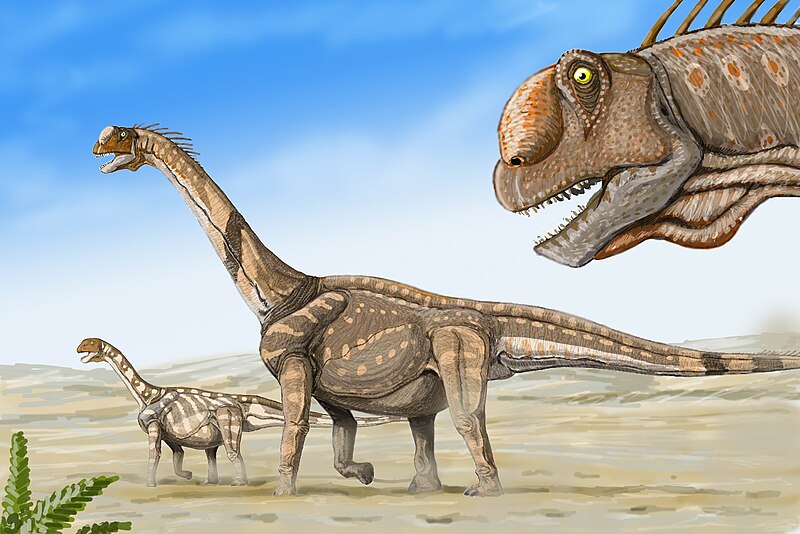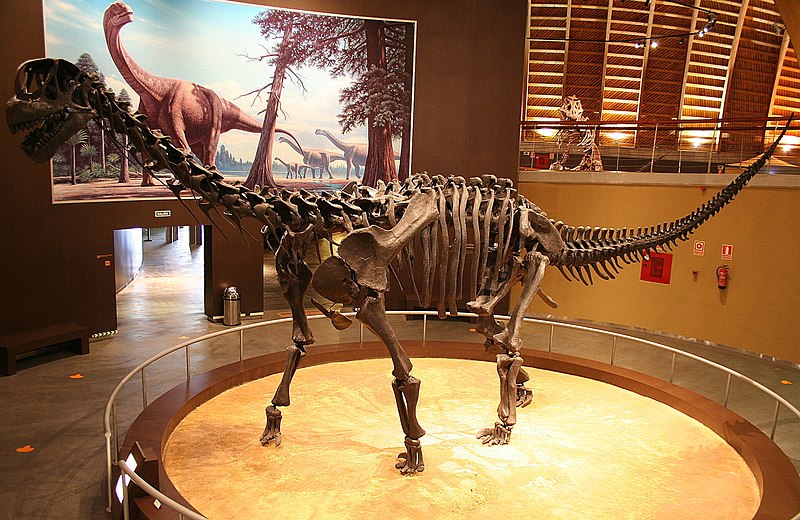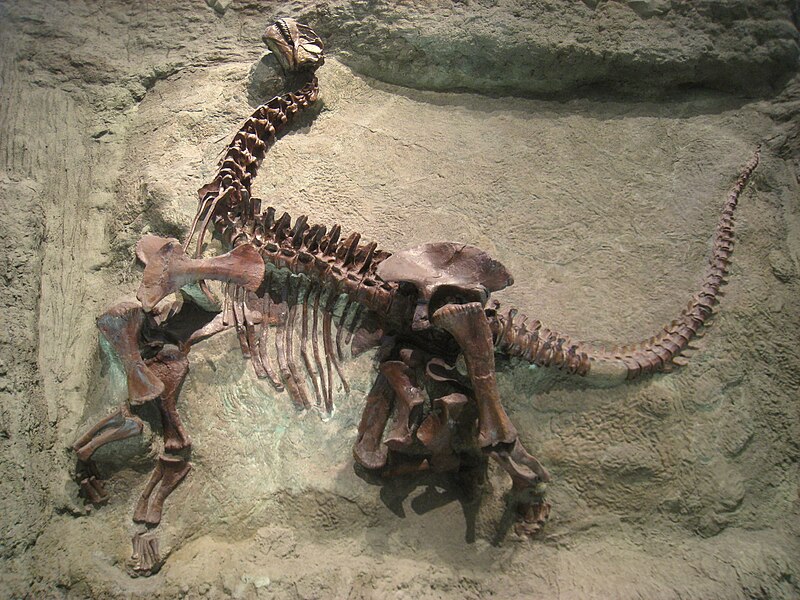[Recent Entries][Archive][Friends][User Info]
August 3rd, 2012
| August 3rd, 2012 | |
|---|---|
| 02:30 pm [industrialterro] [Link] |
Camptosaurus Camptosaurus ( On September 4, 1879 William Harlow Reed in Albany County, Wyoming found the remains of a small euornithopod. That same year Professor Othniel Charles Marsh described and named the find as Camptonotus, or "flexible back", from Greek κάμπτω, "to bend" and νῶτον, "back", in reference to the presumed flexibility of the sacral vertebrae. The holotype was YPM 1877, a partial skeleton. The genus was renamed Camptosaurus by him in 1885 because the original name was already in use for a cricket. In 1879, Marsh named C. dispar (type species of the genus) for material he received from his collectors at Quarry 13 near Como Bluff, Wyoming in the Morrison Formation and C. amplus based on the holotype YPM 1879, a foot found by Arthur Lakes at Quarry 1A. The foot was later shown to have belonged to Allosaurus. Throughout the 1880 and 1890s, he continued to receive specimens from Quarry 13 and in 1894 named two additional species: C. medius and C. nanus, based in part on size. Charles W. Gilmore named two additional species, C. browni and C. depressus in his 1909 redescription of the Marsh specimens. In the Morrison Formation, Camptosaurus fossils are present in stratigraphic zones 2-6. Then in 1980, Peter Galton and H.P. Powell in their redescription of C. prestwichi (see following), considered C. nanus, C. medius and C. browni to be different growth stages or different gender of the larger C. dispar, and therefore only C. dispar was a valid species. They also considered a skull, YPM 1887, in 1886 referred to C. amplus by Marsh, later confirmed by Gilmore, to belong to C. dispar as well. Gilmore had used this skull to describe the skull of Camptosaurus, but the specimen was recently shown by Brill and Carpenter not to belong to Camptosaurus. In 2007, they put it into its own genus and species, Theiophytalia kerri. Camptosaurus depressus was recovered from the Lakota Formation near the town of Hot Springs, South Dakota. It was described by Charles Gilmore in 1909 based on the holotype and only known specimen USNM 4753, a fragmentary postcranium, by the "narrowness or depressed nature of the ilia". Carpenter and Wilson (2008) referred this species to Planicoxa, as P. depressa, on the basis of similarities between its ilium and the holotype ilium of Planicoxa venenica. However, McDonald and colleagues (2010), and McDonald (2011) found that the horizontal postacetabular process of C. depressus is more likely a product of distortion. Therefore, McDonald put it into its own genus, Osmakasaurus. An additional species, Camptosaurus aphanoecetes, was named by Carpenter and Wilson in 2008 for specimens from Dinosaur National Monument. It differs from C. dispar in the lower jaw, shorter neck vertebrae, and straighter ischium ending in a small "foot" among other features. An analysis by Andrew McDonald and colleagues in 2010 suggested that like Cumnoria, C. aphanoecetes is actually more closely related to more advanced iguanodonts (Styracosterna). It has been moved to the new genus Uteodon. Due to the separate status of Uteodon it has become problematic which material from the Morrison belongs to Camptosaurus. The specimens with certainty belonging to Camptosaurus dispar, from Quarry 13, have been recovered from very deep layers, probably dating to the Callovian-Oxfordian. The largest fragments from later strata indicate adult individuals more than 7.9 metres (26 ft) long, and 2 metres (6.6 ft) at the hips. Based on studies of other iguanodonts, scientists believe they may have been able to achieve running speeds of 25 km per hour (15 mph). The Quarry 13 individuals are smaller though. They have been described as reaching 6 metres (19.7 feet) in length and 785 – 874 kg in weight. In 2010 Gregory S. Paul gave an even lower estimate: a length of five metres and a weight of half a tonne. Camptosaurus is a relatively heavily built form, with robust hindlimbs and broad feet, still having four toes. The wrists are strongly ossified allowing the animal to rest on its arms while feeding from low vegetation. The fingers can be spread, not being bound together in a pad, and the thumb carries a small spike. Because Marsh and Gilmore based themselves on the skull of Theiophytalia, many earlier reconstructions of the head of Camptosaurus have been incorrect, showing a much too rectangular profile. The skull was in fact triangular with a pointed snout, equipped with a beak. Its teeth were more tightly packed in the jaw compared to other Morrison euornithopods. Museum curator John Foster describes them as having "thick median ridges on their lateral sides and denticles along their edges," these features were similar to, but "more fully developed" than those in Dryosaurus. Camptosaurus teeth frequently exhibit extensive wear, which indicates that individuals in the genus had a diet of relatively tough vegetation. A tiny 9 inch fossilized embryo, referred to Camptosaurus, was retrieved from Morrison Formation strata at Dinosaur National Monument in Utah. Marsh in 1885 assigned Camptosaurus to a family of its own: the Camptosauridae. Alternatively some authors considered it an early member of the Iguanodontidae. Modern phylogenetics has made Camptosaurus by definition part of the clade Ankylopollexia, of which group it would then be a basal member. This would mean that the genus is closely related to the ancestor of later iguanodontid and hadrosaurid dinosaurs and was more derived than contemporaries such as Dryosaurus, Drinker, and Othnielosaurus. Нижняя челюсть камптозавра содержала несколько рядов зубов с неровными краями, способных без труда срезать и измельчить растительный материал. Края зубов были покрыты множеством мелких острых выступов, легко срезавших листья и ветки. Поскольку растения были очень жесткими, режущие кромки зубов стирались практически полностью. Длинное рыло камптозавра заканчивалось роговым клювом, которым он крепко захватывал и удерживал растения. Вероятнее всего камптозавр имел бочкообразное тело, поскольку ему требовался большой желудок, чтобы переваривать огромный обьем листьев, побегов и веток. У камптозавра были длинные, сильные задние лапы и укороченные передние, поэтому он, скорее всего, передвигался на двух конечностях. Хотя передние лапы камптозавра были слабыми, для того чтобы выдержать значительный вес его теда, кости стопы и кисти были устроены так, что при необходимости камптозавр мог опираться и на все четыре конечности. Это позволяло срывать растения растущие близко к земле. Таким образом динозавр мог легко наклоняться вниз, используя на короткое время передние лапы как подпорки. Камптозавр иногда поднимался на задних лапах, чтобы сорвать сочные молодые побеги. Длинный и тяжелый хвост камптозавра служил в таком случае противовесом. Связки представляют собой прочные, похожие на струну, ткани, соединяющие мышцы с костями. Они имеются в любой части тела, в том числе и на спине, усиливая позвоночник. У большинства животных связки состоят из мягкого, но прочного материала, называемого коллагеном. Связки молодого камптозавра сначала состояли из коллагена, но по мере роста животного коллаген заменялся костным материалом. У взрослого камптозавра связки выглядили как сеть очень длинных тонких костей. Эти кости не только укрепляли позвоночник, но и помогали камптозавру удерживать равновесие, придавая прямую и ровную осанку. Имея длинные задние и короткие передние конечности, капмтозавр ходил только на задних лапах. Он был достаточно тяжелым и вероятно, не мог быстро бегать. В отличие от игуанодона, у камптозавра шип на большом пальце кисти отсутствовал. Пятипалые кисти и четырехпалые ступни заканчивались не когтями, а скорее копытцами. Камптозавры жили стадами и, возможно, уходили на новые места, когда истощались запасы корма. Палеонтологи считают, что камптозавры обладали своеобразными защечными мешками, в которые они набивали большие порции листьев и веточек. Там этот комок пережевывался короткими острыми зубами, расположенными в несколько рядов. Мощные четырехпалые задние ноги помогали уйти от преследователя. Опираясь на них, камптозавр длинным языком собирал листья с деревьев и саговников, объедал низкорослые растения. Хотя в передней части клювовидной пасти камптозавра не было зубов, он мог пережёвывать растения многочисленными зубами, которые росли в глубине рта. Останки этого динозавра обнаружены на территории Европы и Северной Америки. Ankylopollexia is a clade of herbivorous iguanodontian dinosaurs that lived from the Late Jurassic to Late Cretaceous in all continents. Some members include Camptosaurus, Iguanodon, Ouranosaurus, and the hadrosaurids or "duck-billed dinosaurs". The Ankylopollexia was named by Paul Sereno in 1986 to denote the group within the Iguanodontia that includes the Camptosauridae and the Styracosterna. The name means "stiff thumbs", referring to a possible synapomorphy, possessing a conical thumb spine. Ankylopollexians were generally large animals, and some (such as Shantungosaurus, which measured up to 50 ft (15 m) in length and weighed up to 8 tons) equaled the largest carnivorous dinosaurs in size. The first definition of Ankylopollexia was given by Sereno in 1998. It was defined as the node-based taxon consisting of the last common ancestor of Camptosaurus, Parasaurolophus and all his descendants. Sereno (2005) improved this definition, using the type species, Camptosaurus dispar (Marsh 1879) and Parasaurolophus walkeri (Parks 1922), instead of the genera. Many ankylopollexians have not yet been included in a large phylogenetic analyses, or are too fragmentary to place confidently. These include Bihariosaurus, Delapparentia, Dollodon, Draconyx, Hypselospinus, Lurdusaurus, Osmakasaurus, Owenodon, Planicoxa, Proplanicoxa and Sellacoxa. The simplified cladogram below follows an analysis by Andrew McDonald and colleagues, published in November 2010 with information from McDonald, 2011. Орнитоподы (Ornithopoda, от др.-греч. ὄρνις, род. п. ὄρνιθος — птица и др.-греч. πούς — «нога») — инфраотряд птицетазовых травоядных динозавров. Жили от позднего юрского периода до конца мелового периода. Многие из них имели крупные размеры, игуанодон, встав на дыбы, достигал 10 (в некоторых случаях даже 13) метров. Передние лапы у них обычно были значительно более короткими (в 1,5—2 раза) и не столь сильными, как задние. Поэтому ранее считалось, что они передвигались исключительно на задних конечностях; согласно последним исследованиям, использовали при ходьбе также и передние лапы. Зубы срастались по всей длине челюсти, а про вертикали состояли из нескольких коронок, заменявшихся новыми по мере стачивания. Игуанодоны — наиболее известные и ранее всего открытые динозавры этой группы. Гадрозавры и родственные им виды за своеобразную форму морды, напоминающую клюв, получили прозвание «утконосых». Они были меньше игуанодонов (3—4 м). Цераподы (Cerapoda) — один из двух подотрядов или групп птицетазовых динозавров. Цераподы были травоядными динозаврами, которые жили на всех континентах. Название таксону было дано Полом Серено в 1986 году (таксон был указан как "Nanorder"). Ныне первоначальная классификация была пересмотрена и не сохранилась. Было высказано мнение о монофилетичности группы Батлером и его коллегами в 2008 году, а также Салливаном в 2009 году. Некоторые ученые относят Micropachycephalosaurus hongtuyanensis в семейство пахицефалозавров. Батлер и Ци (2009) считают его членом клады Ceropoda, потому что голотипу не хватает "однозначной синапоморфии пахицефалозавра", в то время как Салливан (2006) считает, что данный таксон является вовсе nomen dubium. Голотип Micropachycephalosaurus hongtuyanensis, в котором отсутствуют череп материала, считался взрослой особью Перл и др.. (1982), но недавно это было пересмотрено, и теперь он определяется как несовершеннолетняя особь (Батлер и Ци, 2010).
Ископаемые останки (1, 2, 3, 4):
Tags: Вымершие рептилии, Юра, авеметатарзалии, анкилополлексии, архозавроморфы, архозавры, диапсиды, динозавроморфы, динозавры, игуанодонты, неорнитискии, орнитоподы, птицетазовые, цераподы |
| Time | Event |
| 03:20 pm [industrialterro] [Link] |
Camarasaurus Camarasaurus ( Camarasaurus is among of the most common and frequently well-preserved sauropod dinosaurs. The maximum size of the most common species, C. lentus, was about 15 meters (50 ft) in length. The largest species, C. supremus, reached a maximum length of 23 meters (75 ft) and maximum estimated weight of 47 tonnes (51.8 tons). The arched skull of Camarasaurus was remarkably square and the blunt snout had many fenestrae, though it was sturdy and is frequently recovered in good condition by paleontologists. The 19 centimeter long (7.5 in) teeth were shaped like chisels (spatulate) and arranged evenly along the jaw. The strength of the teeth indicates that Camarasaurus probably ate coarser plant material than the slender-toothed diplodocids. Each front limb bore five toes, with the inner toe having a large sharpened claw. Like most sauropods, the front limbs were shorter than the hind legs, but the high position of the shoulders meant there was little slope in the back. Serving the purpose of weight-saving, as seen in other sauropods, many of the vertebrae were hollowed out or pneumatic, riddled with passages and cavities for an intricate system of air sacs connected to the lungs. This feature was relatively unknown at the time Camarasaurus was discovered, and was the inspiration for its name, meaning "chambered lizard". The neck and counterbalancing tail were shorter than usual for a sauropod of this size. Camarasaurus, again like certain other sauropods, had an enlargement of the spinal cord near the hips. Palaeontologists originally believed this to be a second brain, perhaps necessary to co-ordinate such a huge creature. However, while it would have been an area of large nervous, probably reflex (automatic) activity, it was not a brain, and such enlargements are actually found to some degree in all vertebrate animals. Camarasaurus lewisi and C. grandis both had more robust radii than fellow sauropod Venenosaurus. There is a fossil record of two adults and a 12.2 meter (40 ft) long juvenile that died together in the Late Jurassic Period, approximately 150 million years ago (in north east Wyoming, USA, excavated by the Division of Vertebrate Paleontology of the University of Kansas Natural History Museum and Biodiversity Center, during the 1997 and 1998 'field seasons'). It is assumed that their bodies were washed to their final resting place, in alluvial mud, by a river in spate. This suggests that Camarasaurus traveled in herds or, at least, 'family' groups. Also, recovered camarasaur eggs have been found in lines, rather than in neatly arranged nests as with some other dinosaurs, which appears to suggest that, like most sauropods, Camarasaurus did not tend its young. Previously, some scientists had suggested that Camarasaurus and other sauropods may have swallowed stones (gastroliths) to help grind the food in the stomach and then regurgitated or passed them when they became too smooth. However, more recent analysis of the evidence for stomach stones has suggested that this was not the case. Furthermore, the strong, robust teeth of Camarasaurus in particular were more developed than those of most sauropods, indicating that it may have processed food in its mouth to some degree before swallowing The type species of Camarasaurus is Cope's original species, C. supremus (meaning "the biggest chambered lizard"), named in 1877. Other species since discovered include C. grandis ("grand chambered lizard") in 1877, C. lentus in 1889, and C. lewisi (originally described as a the new genus Cathetosaurus) in 1988. C. supremus, as its name suggests, is the largest known species of Camarasaurus and one of the most massive sauropods known from the late Jurassic Morrison Formation. Besides its huge size, it was nearly indistinguishable from C. lentus. C. supremus was not typical of the genus as a whole, and is only known from the latest, uppermost parts of the formation. C. grandis and C. lentus were both smaller and present in the earlier stages of the Morrison. Stratigraphic evidence suggests that the chronological sequence of the Camarasaurus species aligned with their physical differences and describe an evolutionary progression within the Morrison Formation. C. grandis is the oldest known species, present in the lowest rock layers of the Morrison. C. lentus appeared later, and co-existed with C. grandis for several million years, possibly due to different ecological niches suggested by differences in the spinal anatomy of the two species. At a later stage, C. grandis disappears from the rock record, leaving only C. lentus, which then also disappeared at the same time C. supremus appears in the uppermost layers. This immediate succession of species, as well as the very close similarity between the two, suggests that C. supremus may have evolved directly from C. lentus, representing simply a larger, later-surviving population of animals. Первое упоминание об этом ящере датировано 1877 годом, когда О. В. Лукас нашел несколько изолированных позвонков в штате Колорадо, а Эдвард Дринкер Коп дал им название. Первое описание целого скелета сделано в 1925 году Чарльзом В. Гилмором. Скелет принадлежал молодой особи и очень часто именно его и изображают на иллюстрациях. Сам камаразавр вероятно достигал длины 18 метров (60 футов). Он был растительноядным животным. Сложенная верхнеюрскими породами формация Моррисон расположена на восточных склонах Скалистых гор, где простирается с севера на юг по территории штатов Монтана и Нью-Мексико, США. На залитых водой и поросших лесом долинах и дельтах рек в поздней юре происходило накопление глин и илов этой формации, там и обитали все виды зауропод — диплодоки, апатозавры, брахиозавры и многие другие. Но ни один вид не был столь многочисленным, как камаразавр. Важнейшая отличительная особенность камаразавра — строение его черепа. Он был большим, немного походим на коробку и насчитывал много окон — больших отверстий между костями. Зубы ложковидной формы располагались по всей длине челюстей, а не только в передней их части, как у представителей подсемейства диплодоцид. Передние ноги были короче задних, как у большинства зауропод, но лопатки оставались высокими, так что спина его вряд ли наклонялась вперед. Позвонки не имели длинных отростков, поэтому маловероятно, что камаразавр поднимался на задних ногах. Шея и хвост его были короче, чем у большинства зауропод. Наличие сильных зубов говорит о том, что камаразавр питался более твердой пищей, чем диплодоциды. Скорее всего, он заглатывал камни, с помощью которых в желудке перетиралась пища. Найденные в формации Моррисон кучи отполированных камней — возможное свидетельство того, что животное, похожее на камаразавра периодически освобождалось от камней из желудка, как это делают современные куры, когда желудочные камни у них истираются (прим. - на самом деле, точное назначение камней-гастролитов для камаразавра неизвестно).
Репродукции (1, 2, 3, 4, 5, 6, 7, 8, 9):
( Далее ) Ископаемые останки (1, 2, 3, 4, 5, 6, 7, 8, 9):
( Далее ) Tags: Вымершие рептилии, Юра, авеметатарзалии, архозавроморфы, архозавры, диапсиды, динозавроморфы, динозавры, завроподоморфы, завроподы, макронары, ящеротазовые |
| Previous Day | 2012/08/03 [Archive] |
Next Day |


















